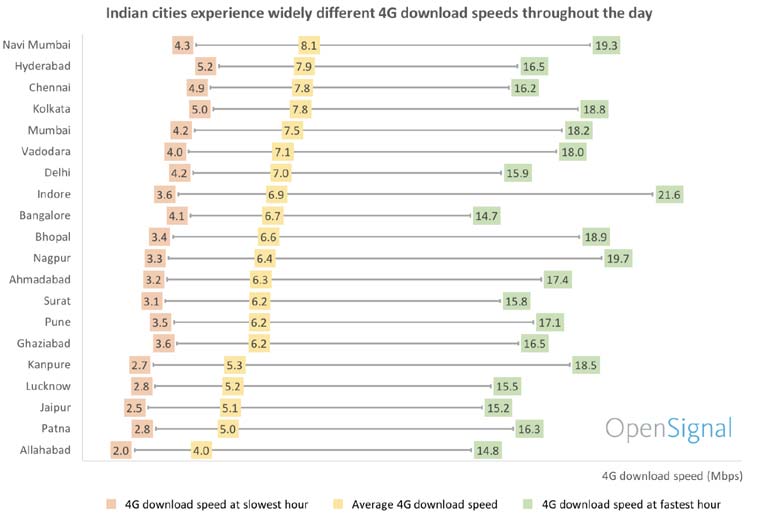
India’s 4G download speeds are nearly 4.5 times faster at night, according to OpenSignal, the company known for tracking internet speeds globally. OpenSignal says its conclusion is based on measuring 4G download speeds in 20 largest Indian cities.
The speeds improve at around 4.00 am with average download speeds hitting 16.8 Mbps in 20 cities. This is much higher compared with the daily average of 6.5 Mbps. However, at 10 pm in the night, smartphone users experience the slowest speeds given congestion is highest, shows the data.
According to OpenSignal’s research, users in India are experiencing “widely different” speeds at different hours of the day. In fact, the daily average LTE download speed drops to 2.8 Mbps during the busiest hours.
In terms of individual cities, Navi Mumbai scored the highest of 8.1 Mbps in average LTE download speeds, while Allahabad came last with an average of 4.0 Mbps. The daily average for Allahabad was also lower at 2 Mbps.
While speeds drop significantly during network congestion, there is a significant jump in the average by 10.3 Mbps during the less busy hours of the day. In this, the city of Indore had highest speed of 21.6 Mbps, and all 20 cities are above the 14 Mbps in this duration.
As OpenSignal points out the wide range of mobile broadband speeds shows the kind of challenges that India’s telecom operators face. With India being a smartphone first market, and the kind of data revolution it has seen after the Jio’s entry, more and more users are consuming data on their mobile phones, putting more stress on the networks.

OpenSignal’s data also showed that “by comparing each city’s average worst versus best hourly speed, they found that smartphone users can experience 4G download speeds three to seven times faster by connecting to the network at a different time.” In terms of consistent speeds, Hyderabad was on top while Allahabad had the highest variance.
Lowest 4G speeds at 10 pm, best 4G speeds at 4 am
“All the cities show a similar trend with download speeds tending to decrease over the course of the day, reaching the slowest speed in the late evening at 10 pm,” says OpenSignal. This is the time when smartphone users are likely connected to the network for entertainment purposes, such as watching videos or social media browsing before they go to sleep.
The speeds peak at 4 am because this is when most people are asleep. As more users wake up, the speeds start falling again.

“The hourly results show clearly that the time of the day, and consequently the proportion of smartphone users that are likely to connect to the network, explain a big part of the difference in experience,” says OpenSignal.
The 4G download speeds range from 2.5 Mbps to 5.6 Mbps during peak hours, which is a 3.1 Mbps difference, but during less-congested hours, the speeds experienced increased by approximately 9.8 Mbps to range from 9.9 Mbps to 19.7 Mbps.
The report says that “network congestion is one of the main reasons why smartphone users in India experience relatively slow average 4G download speeds.” This is not surprising given the high urban population density and that more users are accessing the internet from mobiles.
Another key observation from OpenSignal: Users experience speeds over 20 Mbps at quiet times, and this only occurs in the middle of the night.
In the daytime, the large number of connected devices are hampering capacity of networks and resulting in a poor browsing experience for users.
According to the company, Indian telecos will have to look at increasing network capacity to offer more consistent experience. With India, more users will come online via their mobiles, increasing the number of connected smartphones, other devices, and thus adding to the already existing strain on the network.